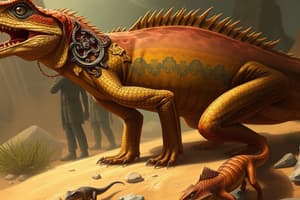Podcast
Questions and Answers
List specialized characteristics of reptiles.
List specialized characteristics of reptiles.
They all have a backbone, they produce eggs, they have scales, and are cold-blooded.
Describe amniotic eggs.
Describe amniotic eggs.
The amnion is a set of fluid-filled membranes. Amniotic fluid is the fluid inside the amnion that acts as a cushion to help protect the developing embryo from physical danger.
List the groups of animals that comprise the reptiles and describe their general characteristics.
List the groups of animals that comprise the reptiles and describe their general characteristics.
Reptiles are tetrapod animals in the class Reptilia, including turtles, crocodilians, snakes, amphisbaenians, lizards, and tuatara.
Compare and contrast snakes and lizards.
Compare and contrast snakes and lizards.
Describe reptile scales and the functions they serve.
Describe reptile scales and the functions they serve.
What are testudines?
What are testudines?
Describe two senses that reptiles may use to locate prey.
Describe two senses that reptiles may use to locate prey.
What is a diaphragm? What does it do?
What is a diaphragm? What does it do?
Explain how you might stay warm on a cold day if you were a reptile such as a lizard.
Explain how you might stay warm on a cold day if you were a reptile such as a lizard.
Which groups of species are amniotes?
Which groups of species are amniotes?
Describe important traits of reptiles that helped their success.
Describe important traits of reptiles that helped their success.
Give examples of groups of reptiles.
Give examples of groups of reptiles.
Explain why reptiles were able to replace amphibians as the dominant land vertebrates.
Explain why reptiles were able to replace amphibians as the dominant land vertebrates.
Which animals comprise the Crocodilia?
Which animals comprise the Crocodilia?
Which animals comprise the Squamates?
Which animals comprise the Squamates?
Flashcards are hidden until you start studying
Study Notes
Specialized Characteristics of Reptiles
- Reptiles possess a backbone (vertebrates) and are cold-blooded (ectothermic).
- They reproduce by laying eggs and have protective scales covering their bodies.
Amniotic Eggs
- Composed of fluid-filled membranes; the amnion protects the developing embryo.
- Amniotic fluid cushions the embryo, safeguarding it from physical harm.
Groups of Reptiles
- Class Reptilia includes turtles, crocodilians, snakes, amphisbaenians, lizards, tuatara, and extinct relatives.
- Reptiles are tetrapods, meaning they typically have four limbs (although snakes have evolved without them).
Snakes vs. Lizards
- Lizards have legs, while snakes lack limbs entirely.
- Movement differs: lizards walk on four legs, yet snakes propel themselves by undulating their bodies.
Functions of Reptile Scales
- Scales are made of tough keratin, providing protection and preventing water loss.
- They also aid in camouflage and defense against predators.
Testudines
- An order within reptiles, including all turtles, tortoises, and terrapins.
Reptilian Prey Detection
- Snakes utilize their forked tongues to sense chemicals in the air, helping identify prey.
- Some snakes have heat-sensing organs to detect warm-blooded prey like mammals and birds.
Diaphragm in Reptiles
- Acts as the main muscle for respiration, enabling breathing by contracting and relaxing.
- Positioned beneath the lungs and heart, facilitating airflow during inhalation and exhalation.
Temperature Regulation in Reptiles
- Reptiles rely on environmental heat to maintain body temperature, especially in cold conditions.
- This ability helps them conserve energy and adapt to varying temperatures.
Amniotes
- Amniotes comprise synapsids and sauropsids, expanding back to amphibian ancestors.
Success Traits of Reptiles
- Developed thick, scaly skin that minimizes moisture loss, aiding survival in arid environments and on land.
Varied Groups of Reptiles
- The reptilian class includes an extensive range of species: snakes, lizards, alligators, crocodiles, turtles, worm-lizards, and caimans.
Evolutionary Dominance Over Amphibians
- Reptiles began to replace amphibians as dominant terrestrial vertebrates around 365 million years ago.
- Fossil analyses indicate amphibians evolved from lobe-finned fish ancestors.
Crocodilia Order
- The order includes true crocodiles, alligators, caimans, gharials, and false gharials.
Squamates Diversity
- Squamates represent the most diverse reptile group, with around 7,400 recognized species.
- This group encompasses lizards, snakes, and worm lizards, distinguished by shared characteristics.
Studying That Suits You
Use AI to generate personalized quizzes and flashcards to suit your learning preferences.




